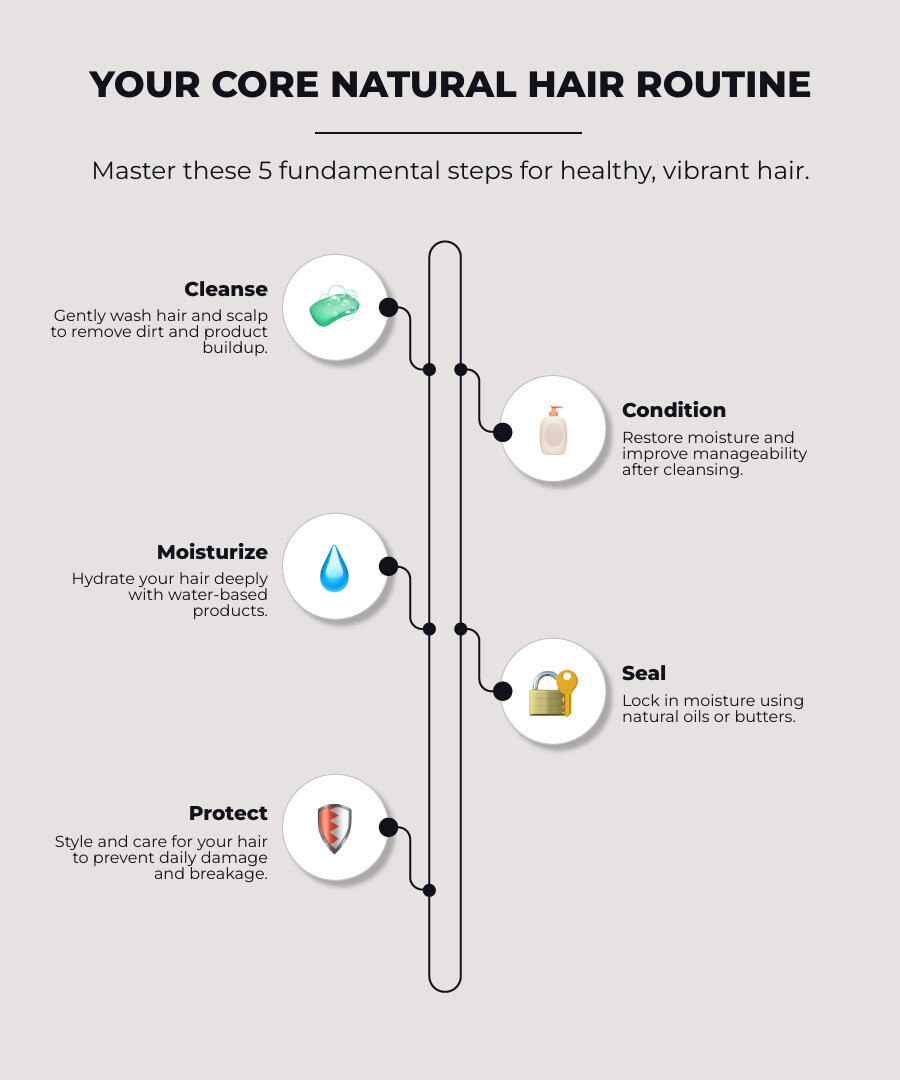Understanding Your Natural Hair Care Routine
A natural hair care routine is a personalized system of steps and products designed to keep your hair healthy, moisturized, and strong. It’s about consistent care that lets your hair truly thrive.
Here are the essential steps in a natural hair care routine:
- Cleanse: Gently wash your hair and scalp.
- Condition: Restore moisture and improve manageability.
- Moisturize: Hydrate your hair with water-based products.
- Seal: Lock in moisture with oils or butters.
- Detangle: Carefully remove knots to prevent breakage.
- Protect: Style and care for your hair to avoid damage.
- Maintain Consistency: Follow your routine regularly for best results.
“Curly hair needs love and care.” This simple truth guides the natural hair journey. A solid natural hair care routine is like a meal plan for your hair, providing the structure and consistency needed for healthy, strong growth.
Embracing your natural texture is also a step towards wellness. Some chemical treatments have been linked to health risks; a Boston University study showed that frequent use of chemical hair relaxers by Black women increased breast cancer risk by nearly 30 percent. This highlights the importance of a natural approach.
This guide will help you build a routine for your unique hair, covering everything from cleansing to styling. You’ll learn to moisturize, prevent breakage, and protect your hair for long-term health.

Learn more about natural hair care routine:
The Core Pillars of Your Natural Hair Care Routine
This section will detail the fundamental, non-negotiable steps for building a successful routine that promotes health and growth from the scalp to the ends.
Cleanse: The Foundation of a Healthy Scalp
A clean scalp is the foundation of your natural hair care routine. Product buildup, dirt, and oils can clog hair follicles, leaving hair dull and lifeless.
How often should you wash? Most people with natural hair wash between once a week to once a month. Looser curls may need washing every 2-3 days, while kinky or coily hair often thrives with a wash every one to two weeks. A bi-weekly wash works well for most natural hair types, which tend to be drier.
Listen to your hair. If it feels limp, dull, or greasy, wash more often. If it feels dry or brittle, you might be over-washing.
Choose sulfate-free shampoos to avoid stripping your hair’s natural oils. While co-washing (washing with conditioner only) is great between shampoos, don’t skip a proper cleanse entirely.
Every few months, use a clarifying treatment like bentonite clay to hit the reset button and remove deep-seated buildup.
Pro tip: focus shampoo on your scalp, not the ends. Mix it with water in your palm to make it gentler. A scalp massage during washing can stimulate blood flow for healthier growth.
Advanced Steps for Optimal Hair Health
Once you’ve mastered the basics, incorporating these advanced practices can lift your hair’s health, protect it from damage, and ensure you retain the length you work so hard to grow.
Style & Protect: Reducing Daily Manipulation
Protective styles are crucial in a healthy natural hair care routine. They give your hair a break from daily manipulation, heat, and environmental stressors. By tucking away your ends—the oldest and most fragile part of your hair—these styles help you retain length and prevent breakage.
Popular protective styles include twists (two-strand or flat), braids (box braids, cornrows), and buns. Styles like box braids can last up to two months, offering a great break from daily styling. Just ensure they aren’t too tight, as this can cause tension and stress on your scalp.
Protect your hair while sleeping by covering it with a satin bonnet or using a silk or satin pillowcase. Cotton absorbs moisture and creates friction, leading to frizz and breakage. Also, shield your hair from harsh weather with hats and scarves.
Specialized Treatments: Protein, Trims, and Detox
Beyond your regular routine, certain treatments are vital for optimal hair health.
Protein treatments are essential because hair is primarily made of protein. If your hair feels limp or mushy, it may need a protein boost. These treatments strengthen the hair shaft and improve elasticity. Aim to use one every 6-8 weeks.
Regular trims are key for length retention. Trimming your hair every 3 months prevents split ends from traveling up the hair shaft and causing more damage. A quick trim keeps ends neat and healthy.
Even with gentle shampoos, product buildup can occur. Use clarifying and detox treatments, like a Bentonite clay mask, every two or three months. These masks draw out impurities and reset your hair, helping your regular products work better. For more ideas, check out our DIY Natural Beauty Tips.
The Role of Diet and Supplements
What you put into your body significantly impacts your hair’s health. A balanced diet is fundamental for growing strong, vibrant hair.
Ensure your diet includes these hair-loving nutrients:
- Protein: Crucial for growth and strength. Find it in lean meats, fish, eggs, beans, and nuts.
- Iron: Low iron can contribute to hair loss. Boost your intake with spinach, lentils, and red meat.
- Zinc: Supports hair tissue growth and repair. Found in oysters, pumpkin seeds, and legumes.
- Hydration: Drinking plenty of water is essential for keeping your hair and scalp hydrated.
Supplements can help fill nutritional gaps. Biotin is a popular supplement known to support hair growth and strength. To further support your journey, consider our Biotin Gummies for Hair Growth.
Customizing Your Routine: What Works for YOU?
There is no one-size-fits-all answer in a natural hair care routine. This section focuses on how to listen to your hair, avoid common pitfalls, and create a sustainable routine that fits your unique needs and lifestyle.
Finding Your Frequency: A Personalized Natural Hair Care Routine
Your hair’s hair type (fine or thick), porosity (how it absorbs moisture), and scalp oiliness will shape your perfect routine. Finding what works is a journey of trial and error.
For instance, while many use the LOC (Liquid, Oil, Cream) or LCO (Liquid, Cream, Oil) methods, water is your hair’s primary moisturizer. Oils are sealants. Using too much oil, or applying it before water, can block moisture from entering the hair shaft. Some people find minimalist routines, focusing on cleansing and water-based hydration before a light seal, work best.
While hair porosity is a factor, it’s often most critical for damaged hair. Start with general best practices and adjust your routine based on how your hair feels. If it’s dry, add more moisture. If it’s weighed down, you may be using too much product.
Adjust for seasons, as hair may need more moisture in winter and lighter products in summer. Keeping a hair journal to track products and results can help you find what makes your hair happy.
Common Mistakes to Avoid on Your Natural Hair Journey
Knowing what to avoid can save you from common hair woes.
- Over-washing: Washing too often can strip natural oils, leading to dryness and frizz.
- Harsh sulfates: These can be too aggressive, leaving hair dry and brittle. Choose sulfate-free shampoos.
- Heat damage: Excessive heat from styling tools can damage your hair’s structure. Air dry when possible, and always use a heat protectant on the lowest effective setting.
- Tight hairstyles: While protective styles are great, if they’re too tight, they can cause breakage or even hair loss.
- Skipping deep conditioner: This is a must for keeping natural hair moisturized and healthy.
- Dry detangling: This is a recipe for breakage. Always detangle on damp, conditioned hair for slip.
- Product overload: Using too many products can cause buildup and weigh hair down. Keep it simple.
- Comparing your hair: Every head of hair is unique. Focus on what makes your hair healthy.
Learn How to Fix Frizzy Hair in Humid Weather.
Building Consistency for Long-Term Results
Consistency is key for a successful natural hair care routine. A good routine is a habit woven into your life.
Schedule wash days to make it easier to stick to your routine. Keep it simple, especially at the start. A complicated routine can be overwhelming. Focus on the core steps and add advanced treatments as you get comfortable.
Try habit stacking by integrating hair care into existing routines, like your evening shower. Finally, track your progress. Notice if your hair feels softer, stronger, or has less breakage. Celebrating these small victories will keep you motivated.
Frequently Asked Questions about Natural Hair Care
Starting on a natural hair care routine often brings up a lot of questions. Let’s tackle some of the most common ones.
How long does it take to see results from a new natural hair care routine?
Patience is key. While you might notice initial positive changes like softer, more moisturized hair within a few weeks, more significant improvements take time. Visible length retention or a major change in hair health typically requires several months of commitment.
As we recommend trimming every 3 months, a healthy hair journey is a long-term process. Your hair’s starting condition, type, and your consistency all play a role in the timeline. Stick with it, and you’ll see progress.
Can I use natural oils to moisturize my hair?
This is a common question with an important distinction: natural oils are excellent for sealing moisture, but they are not moisturizers themselves. Water is the ultimate moisturizer for your hair.
Oils create a barrier that locks in the hydration you’ve already applied. Some oils, like coconut and olive oil, can penetrate the hair shaft to strengthen it, but many simply coat the hair.
This is crucial for your natural hair care routine. Applying oils to dry hair can block water from getting in, leading to dryness. For best results, use oils as a final step after hydrating your hair with a water-based leave-in conditioner or cream. A small amount focused on the ends is usually enough.
Do I need to do a “big chop” to go natural?
No, you do not need to do a “big chop” to go natural. The choice is entirely personal.
The “big chop” involves cutting off all chemically relaxed or damaged hair at once for a fresh start with your natural texture. It’s a quick, liberating option.
Alternatively, you can choose to “transition.” This means gradually growing out your natural hair while slowly trimming off the relaxed ends over time. The main challenge is managing the two different textures. The point where they meet, the “line of demarcation,” is very fragile and prone to breakage, so gentle handling is essential.
Both methods have pros and cons. The big chop is immediate, while transitioning is gradual. Choose the path that feels right for your comfort level and lifestyle.
Conclusion
Mastering your natural hair care routine is a path of self-findy and self-love. We’ve covered the essentials to help you nurture your unique curls, coils, and waves.
From cleansing and conditioning to the golden rule of moisturizing with water, you now have a solid foundation. We’ve discussed how to seal in hydration, detangle gently, use protective styles, and incorporate specialized treatments like protein and trims. We also touched on how diet and supplements impact hair from the inside out.
The goal isn’t perfection but finding your rhythm, being consistent, and listening to what your hair needs. With gentle handling and a focus on moisture, you’ll learn to understand its language.
Caring for your natural hair is an act of embracing your authentic self and celebrating your unique texture.
Here at Beyond Beauty Lab, we’re passionate about empowering you with knowledge for your beauty and wellness journey. We are committed to bringing you educational content that supports your path to healthy, happy hair.
Ready to continue exploring? Explore our full range of clean beauty products and resources to further improve your natural hair journey and overall well-being.







